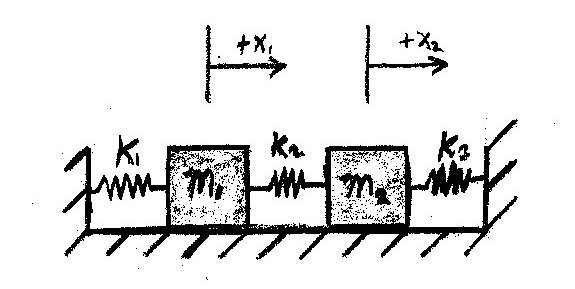Coupled Oscillator: Hellie: Difference between revisions
Jump to navigation
Jump to search
| Line 121: | Line 121: | ||
'''Eigenvalues''' |
'''Eigenvalues''' |
||
<math>\lambda_1=-5.29412\,</math> |
:<math>\lambda_1=-5.29412\,</math> |
||
<math>\lambda_2=2.83333i\,</math> |
:<math>\lambda_2=2.83333i\,</math> |
||
<math>\lambda_3= -2.83333i\,</math> |
:<math>\lambda_3= -2.83333i\,</math> |
||
<math>\lambda_4=0\,</math> |
:<math>\lambda_4=0\,</math> |
||
| Line 162: | Line 162: | ||
.94046 |
.94046 |
||
\end{bmatrix}</math> |
\end{bmatrix}</math> |
||
'''Standard Equation''' |
|||
:<math>x=c_1k_1e^{\lambda_1 t}+c_2k_2e^{\lambda_2 t}+c_3k_3e^{\lambda_3 t}+c_4k_4e^{\lambda_4 t}</math> |
|||
:<math>\ x=c_1</math><math>\begin{bmatrix} |
|||
-.05379\\ |
|||
.28475 \\ |
|||
.17764 \\ |
|||
-.94046 |
|||
\end{bmatrix}\,</math><math>e^{-5.29412}+ c_2\,</math><math> |
|||
\begin{bmatrix} |
|||
-.31854i\\ |
|||
.90253 \\ |
|||
-.09645i\\ |
|||
.27326 |
|||
\end{bmatrix}\,</math><math>e^{2.83333i}+ c_3\,</math><math>\begin{bmatrix} |
|||
.31854i\\ |
|||
.90253 \\ |
|||
.09645i \\ |
|||
.27326 |
|||
\end{bmatrix}\,</math><math>e^{-2.83333i}+ c_4\,</math><math>\begin{bmatrix} |
|||
-.05379\\ |
|||
-.28475 \\ |
|||
.17764 \\ |
|||
.94046 |
|||
\end{bmatrix}, |
|||
</math><math>e^{0}\,</math> |
|||
Revision as of 11:54, 13 December 2009
Problem Statement
Write up on the Wiki a solution of a coupled oscillator problem like the coupled pendulum. Use State Space methods. Describe the eigenmodes of the system.
Initial Conditions:
State Equations
=
With the numbers...
=
=
Eigenvalues
Eigenvectors
Standard Equation
Eigenmodes
- There are two eigenmodes for the system
- 1) m1 and m2 oscillating together
- 2) m1 and m2 oscillating at exactly a half period difference
Solve Using the Matrix Exponential
=
Written by: Andrew Hellie




























![{\displaystyle e^{At}={\mathcal {L}}^{-1}\left\{[SI-A]^{-1}\right\}\,}](https://wikimedia.org/api/rest_v1/media/math/render/svg/7e4f88ccaa345b7b19ab22653c680a22602d0674)
![{\displaystyle [SI-A]\,}](https://wikimedia.org/api/rest_v1/media/math/render/svg/6c3c74fb36f1bde7543f23c3a5d8043ba853a98e)

![{\displaystyle [SI-A]^{-1}=\,}](https://wikimedia.org/api/rest_v1/media/math/render/svg/2047b23a0726b317c3aaa20eb92e668cc8485635)
![{\displaystyle {\mathcal {L}}^{-1}\left\{[SI-A]^{-1}\right\}=\,}](https://wikimedia.org/api/rest_v1/media/math/render/svg/0e116deab4016153edaa8df459ded0df3650c4c6)